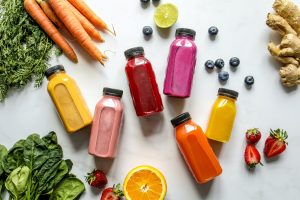 Eating healthy is important for clients in Irvine, CA. Eating healthy also includes what you drink. Too often people opt for diet soda, thinking they’re saving calories, or fruit juice that isn’t fresh squeezed. The problem is that choosing those two drinks too often isn’t healthy. You might think you’re doing yourself a big favor if you choose a bottle of apple juice or give your child a fruit juice pouch, but it’s not necessarily true. It may be just fruit flavored, and similar to soft drinks without the fizzle. Even if it’s labeled 100% pure there are often artificial flavor packs added during the processing.
Eating healthy is important for clients in Irvine, CA. Eating healthy also includes what you drink. Too often people opt for diet soda, thinking they’re saving calories, or fruit juice that isn’t fresh squeezed. The problem is that choosing those two drinks too often isn’t healthy. You might think you’re doing yourself a big favor if you choose a bottle of apple juice or give your child a fruit juice pouch, but it’s not necessarily true. It may be just fruit flavored, and similar to soft drinks without the fizzle. Even if it’s labeled 100% pure there are often artificial flavor packs added during the processing.
Even if it’s fresh squeezed, fruit juice is missing something that fruit still has.
You may wonder why the fruit is healthy, but the fruit juice isn’t. It’s all about what’s missing, not what’s there. That sweet flavor is fructose, a form of sugar, and it can spike your blood sugar just like the sugar in soda. Fruit has fiber and fiber slows the absorption of the fructose. The sugar in the fruit juice spikes your blood sugar, increases insulin levels and even offsets the promised benefits of the vitamins and minerals it contains. While eating the fruit helps metabolism, just drinking the juice can destroy it.
Read the label.
The label may say the sweetness you taste comes from naturally occurring sugar, but that doesn’t mean it comes from the sugar in the fruit itself. If the juice is cold pressed or squeezed fresh, it’s not as bad as the other types of juice, but still has the potential to spike your blood sugar. One popular fruit drink is cranberry juice. If you’ve ever eaten raw cranberries or cooked cranberries without additional sugar, you’ll understand that the cranberry juice has had a lot added to make it palatable.
Drink healthier. Stick with water, infused water, unsweetened tea or black coffee.
The danger of fruit juices is that you let your guard down. You think you’re doing something healthy for your body, but you’re not if you’re drinking it too often. You’re spiking sugar levels, which spikes insulin levels and can lead to prediabetes. It’s also far easier to consume more orange juice than it is to eat whole oranges. It takes 1 ½ oranges to make a ½ cup of orange juice, and they have the same calories. Most people don’t stop at drinking a half cup. The average large drinking glass people use at home is about 1 ¾ cups. It takes about oranges to make that juice. Would you eat that many oranges?
- When comparing a coke to orange juice, coke has 8.97 grams of sugar and the same amount of orange juice has 8.4 grams. That’s pretty close. The difference is that orange juice has more nutrients.
- Both soft drink and fruit juice consumption are linked to type 2 diabetes. Both are closely associated with childhood obesity. Eating fresh fruit isn’t.
- If you’re looking for a healthier drink, consider infused water, green tea or even coffee. Infused water allows slices of fruit to remain in the water then the fruit is removed. It offers more flavor with few if any calories.
- The fructose in fruit juice is about half that of soft drinks, but still high. It’s associated with heart, liver and kidney disease, obesity, high blood pressure and diabetes. The average American diet contains 135 grams, compared to 100 years ago when it was just 15 grams.
For more information, contact us today at Next Level Fitness
